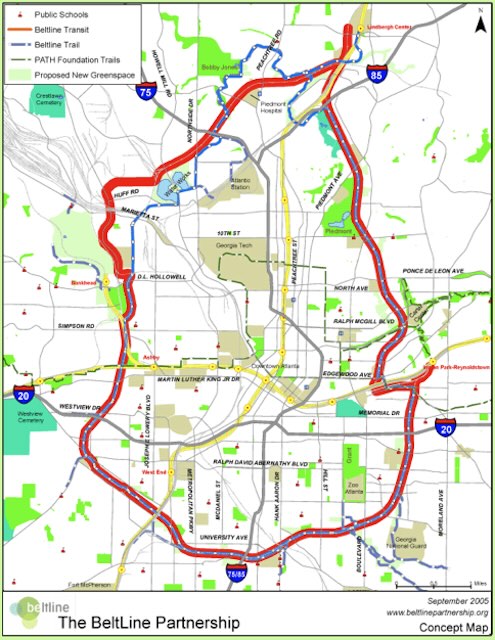Light rail is a “proven technology,” claims Atlanta Beltline engineer Shaun Green, so there is no need to look at alternatives to spending a couple of billion dollars or so building a 22-mile light-rail and streetcar loop around the city. He was responding to some local residents who think that alternatives should be considered because “rail is the 20th century.”
 Proposed route of Atlanta beltline transit system.
Proposed route of Atlanta beltline transit system.
It is sad that even trained civil engineers have lost the simple analytical skills needed to handle questions like this. Let’s look and see where light rail has proven itself.
- It’s proven in Los Angeles, where the high cost of constructing light rail has forced the region to cut bus service, with the result that LA Metro has lost five or more bus riders for every rail rider it gained after it spent well over $12 billion (in today’s dollars) building new light-rail lines.
- It’s proven in St. Louis, which has spent close to $3 billion building more miles of light rail than any city in the Midwest and whose transit system carried fewer riders in 2019 than it did in 1991, the year before it opened the region’s first light-rail line.
- It’s proven in San Jose, which has also spent nearly $3 billion building more than 40 miles of light-rail lines and whose transit system also carried fewer riders in 2019 than it did before it started building light rail.
- It’s proven in Dallas, whose transit system carried 2.26 percent of the region’s commuters to work before building light rail but only 1.57 percent in 2019, after it spent $8 billion building the most miles of any light-rail system in the country. Per capita ridership in the Dallas urban area fell from 19 trips per year before opening its first light-rail line to 13 trips in 2019.
- It’s proven in Houston, where transit ridership fell from 95 million bus trips before opening its first light-rail line to 78 million bus and rail trips in 2019 after spending nearly $4 billion on light rail.
- It’s proven in Portland, which opened its most expensive light-rail line in 2016, costing more than $1.5 billion, after which total transit ridership quickly dropped to its lowest levels since 2007.
- It’s proven in Baltimore, whose transit system carried 107 million riders the year before it opened its first light-rail line and 97 million in 2019. (Baltimore also has a subway line that it opened before the light rail, and transit carried even more riders before opening the subway line than it did after.)
So Green is absolutely correct: light rail is a proven technology. It has proven to be the most expensive way transit agencies can reduce transit ridership . So tell me again: why should Atlanta build a light-rail beltline around the city?








The Beltline is a rare recreational jewel for a city. Shame on MARTA for trying to ruin it.
Same with Metro Transit + the Bruce Vento Trail. They’re trying to ruin that trail with the Purple line. Despite being told transit is meant to get people places they want to go, they insist on ruining trails that have zero shops + offices where people want to go.
Hopefully Marta + Metro Transit will leave the trails alone.
Too lake for Metro Transit’s Southwest Rail line. They’ve spent $3 billion to take away a great trail from the public to connect Minneapolis with the backside of a Walmart and a park n ride. Shameful.